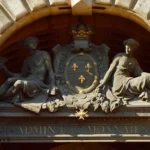Jardin du Luxembourg, a jewel in the heart of Paris, is a haven of tranquility and timeless elegance. This sprawling park, with its meticulously manicured lawns, vibrant flowerbeds, and grand fountains, beckons visitors to escape the city’s hustle and bustle and immerse themselves in a world of natural beauty and cultural treasures. Whether you’re seeking a romantic stroll, a leisurely picnic, or a glimpse into French history and politics, the Jardin du Luxembourg and the neighboring Palais du Luxembourg offer a delightful experience for every traveler. Join us as we explore the enchanting corners of this Parisian oasis, from the iconic Medici Fountain to the hidden artistic gems within the Palais’s walls. This guide will unveil the park’s captivating history, diverse activities, and practical tips for planning your visit, ensuring you make the most of your time in this Parisian paradise.
Jardin du Luxembourg: A Green Oasis
The Jardin du Luxembourg is one of Paris‘ most beloved parks, a sprawling 25-hectare haven of greenery, flowers, and fountains. It’s the perfect place to escape the hustle and bustle of the city, and immerse yourself in nature’s beauty. Whether you’re seeking a quiet spot to read a book, a romantic stroll with a loved one, or a lively game of tennis, the Luxembourg Gardens has something for everyone.
The park’s central feature is the Grand Bassin, an octagonal pond where children sail miniature boats, and adults relax on the surrounding chairs. The Jardin du Luxembourg is also home to a variety of other attractions, including the Medici Fountain, the Orangerie, and the Musée du Luxembourg.
If you’re looking for a truly magical experience, visit the Luxembourg Gardens in the spring or summer when the flowers are in full bloom. The park is especially popular with families, as it has a large playground and plenty of space for children to run and play. However, the Jardin du Luxembourg is also a great place to visit if you’re traveling solo or as a couple. There’s always something to see and do in this beautiful park, no matter what your interests may be.
Palais du Luxembourg: Seat of French Senate
The Palais du Luxembourg is a historic palace located on the edge of the Luxembourg Gardens. It currently serves as the seat of the French Senate, the upper house of the French Parliament. The palace is a beautiful example of French Renaissance architecture, and its interior is decorated with stunning paintings, sculptures, and tapestries.
While the Palais du Luxembourg is not open to the public on a regular basis, it’s possible to visit the palace on certain days of the year. If you’re interested in French history and politics, a visit to the Palais du Luxembourg is a must.
Even if you’re not able to visit the palace interior, it’s still worth taking a walk around the exterior to admire its architecture and gardens. The Palais du Luxembourg is a truly impressive building, and it’s sure to leave you in awe.
Luxembourg Gardens: A Walk Through History
The Luxembourg Gardens have a rich and fascinating history. The gardens were originally created in the early 17th century for Marie de’ Medici, the widow of King Henry IV. Over the years, the gardens have been expanded and redesigned several times, but they have always remained a popular spot for Parisians and tourists alike.
As you stroll through the gardens, you’ll come across a number of historical landmarks, including the Medici Fountain, the Orangerie, and the Musée du Luxembourg. These landmarks all have their own unique stories to tell, and they provide a glimpse into the rich history of the Luxembourg Gardens.
If you’re interested in learning more about the history of the gardens, there are a number of resources available, including guided tours and books. However, even if you don’t have time for a formal tour, simply taking a walk through the gardens and admiring the landmarks is a great way to experience the rich history of this special place.
Palais Architecture: A Blend of Styles
The Palais du Luxembourg is an architectural marvel, showcasing a unique blend of French Renaissance and Baroque styles. Its design was inspired by the Pitti Palace in Florence, a nod to Marie de’ Medici’s Italian heritage. The palace’s imposing facade features ornate details, including columns, pilasters, and statues, while the interior boasts grand halls, gilded ceilings, and opulent furnishings.
Take a moment to admire the palace’s symmetry and harmonious proportions, a testament to the skill of its architect, Salomon de Brosse. Notice the subtle differences between the Renaissance and Baroque elements, such as the contrasting use of geometric and organic forms. The Palais du Luxembourg is a true masterpiece of French architecture, a must-see for any visitor to Paris.
Whether you’re a seasoned architecture enthusiast or simply appreciate beautiful buildings, the Palais du Luxembourg will leave a lasting impression. Its timeless elegance and historical significance make it a true gem of Parisian heritage. Don’t miss the opportunity to explore this architectural wonder and discover the stories behind its walls.
The Medici Fountain: A Romantic Icon
Nestled in the heart of the Luxembourg Gardens, the Medici Fountain is a romantic oasis, a place where lovers stroll hand-in-hand and poets find inspiration. This stunning fountain, adorned with statues of Greek gods and goddesses, was commissioned by Marie de’ Medici in the early 17th century.
The fountain’s centerpiece is a grotto, where water cascades over rocks and moss, creating a tranquil atmosphere. Take a seat on one of the surrounding benches and admire the intricate details of the statues, the graceful curves of the arches, and the play of light on the water. The Medici Fountain is a true masterpiece of Renaissance art, a symbol of love and beauty.
Whether you’re visiting with a loved one or simply seeking a peaceful retreat, the Medici Fountain is a must-see. Let its romantic charm transport you to another time and place, where love stories unfold and dreams come true.
Senate Chambers: Glimpse into Politics
While the Senate Chambers within the Palais du Luxembourg are not always accessible to the public, keep an eye out for special open days or guided tours. These offer a rare opportunity to step into the heart of French politics and witness the grandeur of the Senate’s meeting place.
The Senate Chamber, also known as the Hémicycle, is a semi-circular hall adorned with red velvet seats, gilded balconies, and a majestic ceiling painting. This is where French senators debate and vote on important laws and policies. If you’re lucky enough to visit, take a moment to imagine the passionate speeches and heated debates that have taken place within these walls.
Even if you can’t access the Senate Chamber, you can still appreciate the Palais du Luxembourg’s role as the seat of French political power. Stroll through the courtyard, where senators often gather for discussions, and imagine the important decisions that are made within this historic building. A visit to the Palais du Luxembourg is a chance to witness French democracy in action and gain a deeper understanding of the country’s political system.
Luxembourg Park Activities: Beyond Strolling
The Luxembourg Gardens offer much more than just scenic strolls and historical landmarks. The park is a hub of activity, with something to suit every interest. Sports enthusiasts can enjoy a game of tennis on one of the many courts, or try their hand at boules, a popular French game similar to bocce.
For those seeking a more leisurely pastime, there are plenty of chairs and benches scattered throughout the park, perfect for relaxing with a book or simply soaking up the atmosphere. You can also rent a model sailboat and join the children in racing them across the Grand Bassin, or simply watch the miniature regattas from the shore.
If you’re visiting with children, don’t miss the park’s playground, a wonderland of swings, slides, and climbing structures. There are also puppet shows held regularly, providing entertainment for the whole family. The Luxembourg Gardens are a true haven for both young and old, offering a wide range of activities to enjoy in a beautiful natural setting.
Palais Art Collection: Hidden Treasures
While the Palais du Luxembourg is primarily known as the seat of the French Senate, it also houses a remarkable art collection, often overlooked by visitors. The palace’s walls are adorned with paintings by renowned artists such as Eugène Delacroix and Jean-Baptiste Camille Corot, showcasing the rich history of French art.
The collection also includes sculptures, tapestries, and decorative arts, offering a glimpse into the artistic tastes and cultural values of different eras. While not always open to the public, the Palais du Luxembourg occasionally hosts exhibitions and events that allow visitors to explore its artistic treasures.
Keep an eye out for these special occasions, as they offer a unique opportunity to discover a hidden side of the palace. Even if you can’t access the art collection, simply wandering through the palace’s ornate halls and corridors will give you a sense of its artistic heritage. The Palais du Luxembourg is not just a political institution, but also a repository of cultural treasures waiting to be explored.
Luxembourg’s Children’s Playground: Joyful Noise
One of the most beloved features of the Luxembourg Gardens is its enchanting children’s playground. Filled with the sounds of laughter and excitement, this playground is a haven for children of all ages. With its colorful equipment, imaginative structures, and ample space to run and play, it’s the perfect place for kids to burn off energy and make new friends.
The playground offers a wide range of activities, from swings and slides to climbing frames and sandboxes. There’s also a carousel, a miniature train, and a puppet theater, ensuring there’s never a dull moment. Parents can relax on nearby benches while keeping a watchful eye on their little ones, or join in the fun and rediscover their own inner child.
The Luxembourg Gardens’ children’s playground is more than just a place to play; it’s a place where memories are made. Whether you’re a local or a tourist, a visit to this joyful oasis is sure to bring a smile to your face and a sense of wonder to your heart.
Orangerie & Orchids: Horticultural Delights
The Luxembourg Gardens are a horticultural paradise, boasting a diverse array of plants and flowers from around the world. One of the park’s most impressive features is its Orangerie, a greenhouse that houses a collection of exotic plants, including palm trees, citrus trees, and orchids.
During the colder months, the Orangerie provides a warm and welcoming escape, where visitors can immerse themselves in the lush greenery and fragrant blooms. The Orangerie also hosts temporary exhibitions, showcasing different plant species and horticultural themes throughout the year.
Even if you’re not a gardening enthusiast, the Orangerie is a fascinating place to explore. The sheer variety of plants on display is awe-inspiring, and the peaceful atmosphere provides a welcome respite from the city’s hustle and bustle. Whether you’re admiring the delicate orchids or marveling at the towering palm trees, the Orangerie is sure to leave a lasting impression.
Luxembourg’s Famous Statues: Sculpted Stories
The Luxembourg Gardens are adorned with an impressive collection of statues, each with its own unique story to tell. As you wander through the park, you’ll encounter figures from Greek mythology, French history, and literary classics.
Among the most famous statues are the Queens of France and Famous Women of France, a series of sculptures honoring influential women throughout history. You’ll also find depictions of mythological figures like the Greek goddess Diana and the Roman god Pan.
Take some time to admire the craftsmanship of these sculptures, noticing the intricate details and expressive poses. Each statue offers a glimpse into a different era and a different story, adding to the rich tapestry of the Luxembourg Gardens.
Planning Your Luxembourg Visit: Tips & Tricks
To make the most of your visit to the Jardin du Luxembourg and the Palais du Luxembourg, here are a few tips and tricks:
- Timing: The gardens are open daily from early morning until dusk, but the best time to visit is in the spring or summer when the flowers are in full bloom. The Palais du Luxembourg has limited public access, so check their website for open days and guided tour schedules.
- Transportation: The gardens are easily accessible by public transportation, with several metro and bus lines stopping nearby. If you’re arriving by car, there is paid parking available in the surrounding streets.
- Activities: In addition to strolling through the gardens and admiring the landmarks, there are plenty of other activities to enjoy, such as renting a model sailboat, playing tennis or boules, or visiting the playground with children.
- Food & Drink: There are several cafés and kiosks within the gardens where you can purchase snacks and drinks. If you’re looking for a more substantial meal, there are also a number of restaurants located nearby.
- Photography: The Luxembourg Gardens and the Palais du Luxembourg are incredibly photogenic, so be sure to bring your camera or smartphone to capture the beauty of this special place.
By following these tips, you’re sure to have a memorable and enjoyable visit to the Jardin du Luxembourg and the Palais du Luxembourg.











